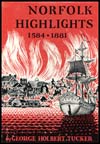Chapter 23
The Coming of the French
Norfolk's population was principally of English, Scotch, and Irish origins until after the Revolutionary War. But with the coming of the French refugees from the slave uprising in Santo Domingo in 1793, the borough became more cosmopolitan.
Discovered by Columbus in 1492 and originally called Espanola, the island, now the Republic of Haiti, was ceded by the Spanish to the French in 1677. It was rapidly colonized by its new owners, and a highly profitable sugar plantation economy, worked by thousands of slaves, was developed.
Most of the slaves, many of whom had been born in Africa, outnumbered all of the other inhabitants of the island ten to one at the time of the outbreak of the French Revolution.
Taking advantage of long-standing differences between their white masters and the mulatto population of the island brought to a head by the unsettled state of affairs in the mother country, the long-restless slaves revolted. And in a few short months the once prosperous French West Indian colony was devastated by savage fighting.
Seeking revenge as well as freedom, the revolting blacks raped, tortured, and killed their former owners and any slaves who remained faithful to them and pillaged and destroyed their property.
News of the horrors that were being perpetrated in Santo Domingo continued to filter into Norfolk by way of incoming ships throughout the 1790s. And in July of 1793, the problem became an acutely local one when a fleet of one hundred and thirty-seven square-rigged vessels loaded to the gunwales with half-starved refugees under the escort of two French ships of the line, three frigates, and three smaller warships sailed into Hampton Roads from Cape Francois (now Cape Haitien) that had been looted and burned by the rampaging slaves.
Although most of the vessels proceeded to Baltimore, many of them sailed up the Elizabeth River to Norfolk, and the borough was suddenly faced with the first out-of-all-proportion relief program in its history.
Writing to the Governor of Virginia on July 6, 1793, Thomas Newton Jr. of Norfolk had this to say concerning the pitiful condition of those on board the ships from Cape Francois:
"Husbands and wives, parents & children are distributed in such a manner that they Know not where to find each other . . . many were taken out of the water & thrown on board the vessels without cloathes or any subsistance whatever."
Three days later in another letter, Newton informed the governor that "20 odd sail" of the flotilla had docked in Norfolk, and "our place is crowded with Frenchmen, and too many Negroes have been brought in with them."
Coming to the assistance of the refugees, the State of Virginia voted a two-thousand-dollar grant, while subscriptions from private sources poured in, not only from Norfolk but also from almost every other town in Virginia.
According to Isaac Weld, the author of "Travels Through North America," who visited Norfolk in 1795, there were between two thousand and three thousand French in Norfolk at one time. But this number was greatly lessened later when many of the refugees either returned to France or moved to other parts of the United States.
Those who remained -- and there were a great many, as shown by Simmon's 1801 and 1806-07 Norfolk Directories, the late Eighteenth and early Nineteenth Century marriage records of the borough, and tombstones in local cemeteries -- became the ancestors of many Norfolk families of today.
Chapter
24
Music in Old Norfolk
Norfolk Highlights 1584 - 1881

See the "Table of Contents" for links to every chapter in Norfolk Highlights 1584 - 1881 by George Holbert Tucker.
